Okeanos was named one of Fast Company’s 2022 World Changing Ideas!
+
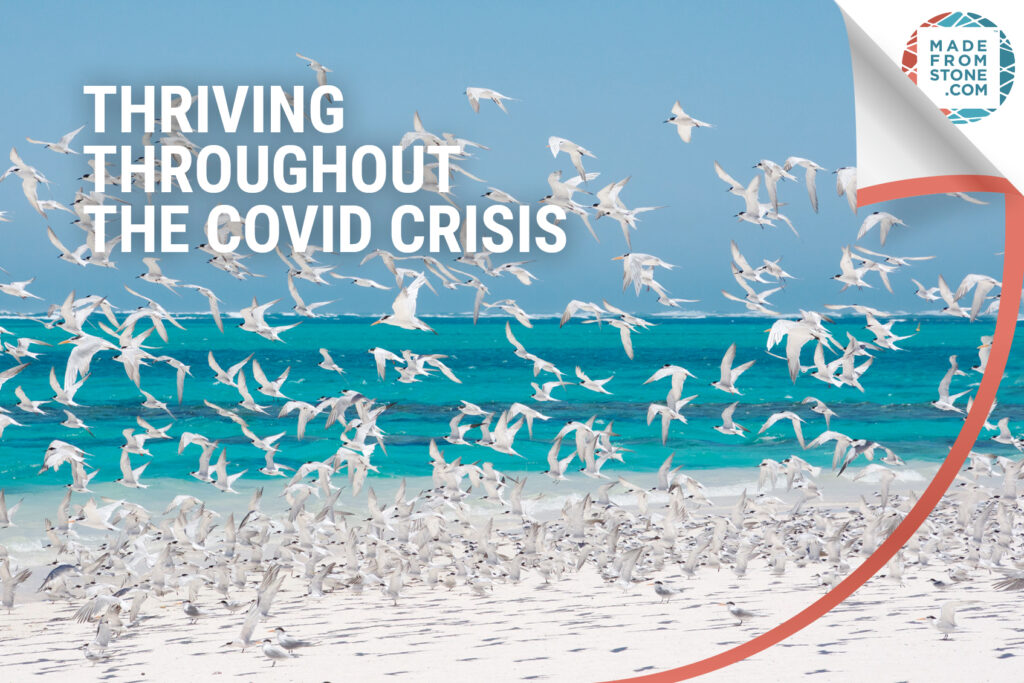
Okeanos®, much like the global body of water it’s named for, is a dynamic community of individuals from a myriad of world cultures. At any given time, someone in Mumbai or Madrid, Bogota or Brooklyn is working toward the reduction of single-use plastic under the Okeanos flag. In March of 2020, just as we were gaining momentum, with increasingly positive product trials, promising sales conversations, and the onboarding of a host of new team members, Coronavirus brought the world to a screeching halt.
Over the next few weeks, countries around the globe pressed pause, and collectively we held our breath. Rarely before has an issue taken hold of every industry, every family, every wallet and every corporeal being. Glued to our TVs, we watched as our neighbors abroad and across the street battled this unseen enemy. Connecting with others only through glass, behind masks, from a distance, and through our screens.
While COVID rages on, fortunately so too does Okeanos; a credit to the company’s strong foundation of global collaboration and commitment to our cause. “Together for the common good,” is a message we understand – a language we all speak. Much like with plastic pollution, what happens to our friends and colleagues over there, whether tragedy or triumph, happens to us all right here.
In 19 languages, 23 nationalities and across 10 countries, we continue our important work together. Our tools and technology allowing us to bridge the divide between our makeshift home offices, and our colleagues halfway around the world. Page after page of friendly faces on our weekly Teams meetings, only a button away. Though half of our team members have never met their colleagues in person or been inside a physical Okeanos office, we remain united by the cause. Our team, built of scientists, doctors, engineers, marketers, and more, have made themselves available to every time zone to dole out advice and support. As a global organization, we are agile, adaptable, and able to shift production of our technology with the everchanging landscape of each country we work in. We continue to provide opportunities and local jobs in various markets during a time of global economic uncertainty.
If anything, COVID has only inspired us to lean in. To push harder. Discarded PPE will be the next enormous environmental challenge the oceans will face, as billions of disposable masks and gloves make their way into the ecosystem. Rollbacks on single-use bans to accommodate sanitizing precautions could set the tone for more ecological destruction. There is much work to be done, but armed with a global team of driven and passionate individuals, and the tools necessary to do the job, we are up for the challenge. Together.
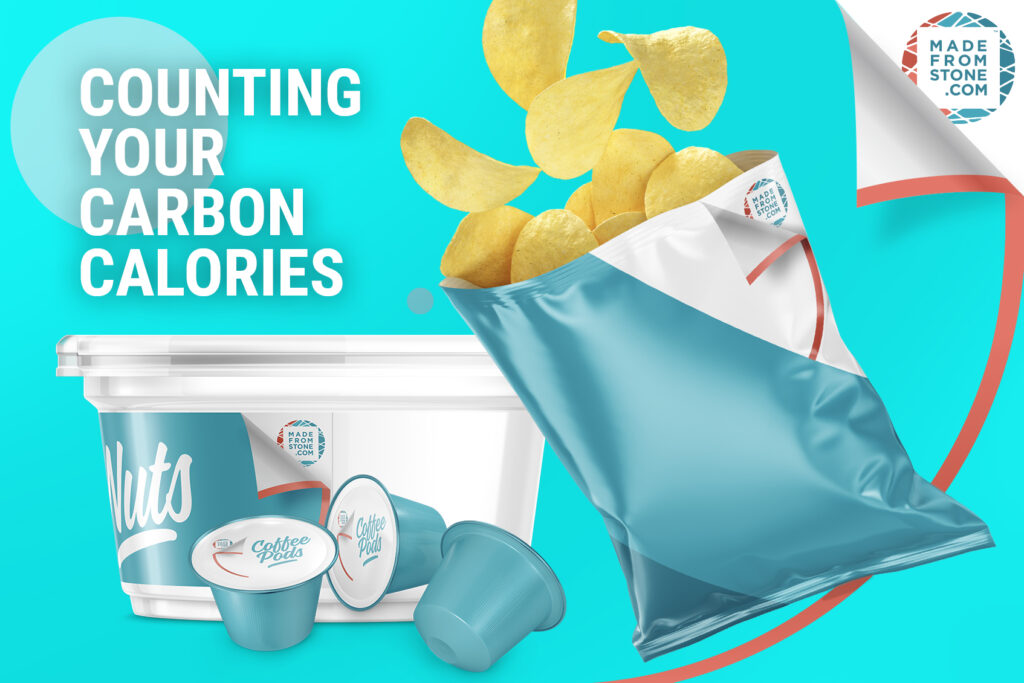
The labels on our favorite foods can tell us lots of things about the item itself, including the ingredients it’s made out of, the nutritional information, often where it’s made, and sometimes even the story of the brand who made it. Somewhere on the bottle or box, you’ll also be able to see what it costs for you to buy it. However, what most labels don’t currently tell you though, is what it costs the planet to make it. That’s about to change.
In order to get people to understand the environmental impact of what they’re consuming, there’s been an increased focus on educating the public about carbon emissions, or the total amount of greenhouse gasses generated by the production and manufacture of an item, typically expressed as a measurement of carbon dioxide (CO2). Greenhouse gasses are responsible for trapping heat in the atmosphere, resulting in warmer climates around the world, poor air quality, changes in weather and entire ecosystems; issues affecting every living thing on this planet. Whether it be a grapefruit or a car, everything we interact with today has a carbon footprint. Recently, in an effort to be more transparent about their impact on the environment, several companies have begun to include the carbon emissions measurements on their packaging. This is a step in the right direction, but the real challenge is helping the average person to interpret those numbers. Education will be an essential factor if carbon emissions labels are to become commonplace. In a recent interview with Forbes, Sam Blunt of Quorn Foods whose company is planning to add carbon emissions labels to their packaging explains, “People get nutritional data on food packaging to help them manage their health, so we think it’s essential to give people carbon emissions data so they can manage the environmental impact of the food they choose to buy.”
Calculating the carbon footprint of a product can be complicated, but responsible brands understand the importance of trying to inform their customers about the ways they are working to minimize their footprint. To figure out how your pint of Cherry Garcia impacts the environment, you have to analyze it’s life-cycle from inception to the end of its life. Celebrated ice cream brand Ben & Jerry’s has taken proactive steps to calculate that each pint of their ice cream contributes up to two pounds of CO2 emissions to the atmosphere. Their website compares their pint to a medium sized car, which generates around one pound of CO2 per mile driven. So, in comparison to the car you used to get to the grocery store, you can feel good about eating the ice cream you buy from there. Ben & Jerry’s then breaks down their emissions by contributing factors, attributing the largest percentage to their ingredients, specifically cream which comes from methane-producing cows.
The production of their packaging alone contributes 10% to their total emissions calculation. While that doesn’t sound like a lot, Ben & Jerry’s produces 528,000 pints a day. That’s a lot of ice cream! There is potential to improve upon this with the help of Okeanos. Packaging using Made From Stone™ technology has a significantly lower carbon footprint than that of other packaging materials on the market. If Ben & Jerry’s pints were packaged in containers Made From Stone, as opposed to the difficult to recycle poly-ethaline paperboard they currently use, it would have a significantly lower carbon footprint, and you could feel even better about enjoying that pint of Phish Food. Our Made From Stone technology can reduce the carbon footprint of packaging by up to 70%.
Here at Okeanos, when we look at packaging, we look at several parameters that can be used to measure its environmental impact. The most widely known and popular is the CO2 footprint. We are encouraged by the inclusion of carbon footprints on labels, and hope it leads to a trend of people making more informed buying decisions with the environment in mind.
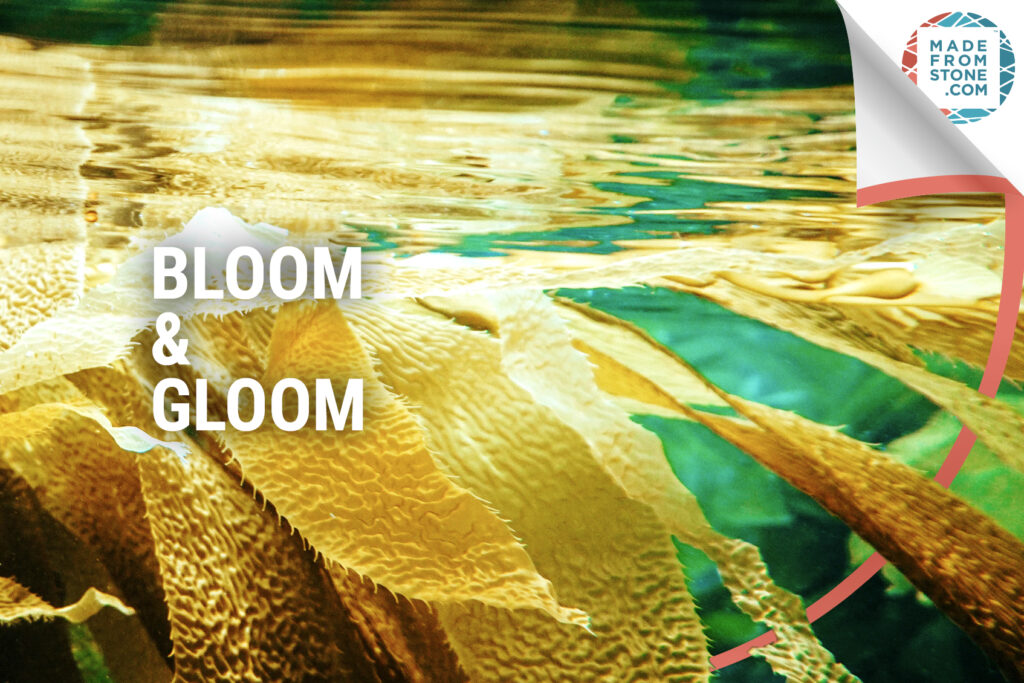
When thinking about the environmental impact of the single-use plastic items, advertising has conditioned us to only consider the journey they will take when we’re finished using them. Often, we pop them into the recycling bin, and mentally pat ourselves on the back for saving the planet, assuming the “recycling gods” will take it from here. However, for the take-out container and plastic fork from lunch, the milk jug, or trendy box of water, the journey is far from over. In actuality, the journey that product took before it wound up in your hands will still play a role long after you’ve disposed of it. Besides CO2 footprint, discussed in the previous article, there are other measures of environmental impact of packaging but one particularly near and dear to our hearts at Okeanos: eutrophication potential. We break it all down for you in a Q&A with our Co-Founder Dr. Russell Petrie.
Q: What is eutrophication potential? And why should we care:
A: Eutrophication is the term ascribed to the potential of a product or process to cause harmful abnormal algae growth in streams, lakes and the ocean as a direct or indirect result of the process of making a particular compound or product. It is frequently reported in a products Life Cycle Analysis (LCA). The concept revolves around creating a harmful algae over-growth (sometimes called a bloom) by introducing additional phosphorus, nitrogen or food for microorganisms into a body of water. Phosphorous and nitrogen are commonly used in fertilizer to enhance growth of plants, but if they get into a body of water, they can cause algae to overgrow. So, anything made out of plant material requiring fertilizer to enhance growth at the beginning of production, will likely have an increased eutrophication potential. In addition, anything that can be a food source for algae or microorganisms, such as waste water, plant material, or biodegradable plastics can add to the eutrophication potential. In other words, have a greater potential to create harmful algae blooms in fresh and saltwater.
Algae blooms are problematic because they remove all the oxygen from the water, killing other animals. Algae blooms also block sunlight from plants below the surface that rely on the sun to grow, causing the plants to decay and die. Eventually the algae die as well. The decaying plants, animals and algae release additional CO2 in the water making the water more acidic. Increased acidity is harmful ocean animals and our reefs. So, eutrophication potential is an important environmental metric from an ocean standpoint.
Q: So, what does this have to do with Made From Stone products?
A: Stone has an incredibly low eutrophication potential. Stone obviously doesn’t require fertilizer to grow, and it can’t be used as a food source for algae. Therefore, as a base material for packaging, it substantially decreases the potential harm to streams, lakes and the ocean compared to many other materials.
Furthermore, unlike paper and even bioplastics or any biodegradable version of plastic, returning CaCO3 to the environment doesn’t require bacterial degradation that results in production of Greenhouse Gases such as CO2 and methane at the end of its lifecycle.
Q: What does the beginning of the lifecycle of packaging Made From Stone look like?
A: Our calcium carbonate (CaCO3) begins and ends its lifecycle in its natural state. It is finely ground into minute particles for processing, very similar to CaCO3 naturally found in soil, rivers, lakes and the ocean. Chemically it doesn’t change from an environmental standpoint– meaning it can be safely returned to the environment without additional treatment. It is then combined with a small amount of resin, and pelletized before becoming your salad bowl, shopping bag, or straw, made out of up to 80% stone.
Q: What does it look like once I’ve used it and tossed it?
A: After use and disposal, a product Made From Stone begins to degrade, and is designed to return the finely ground calcium carbonate to the environment in an easily digestible format, where it will become available for organisms to ingest and use; a vital tool in nature’s toolkit. In the open environment calcium carbonate will neutralize acidity in soil, and in marine environments will combat ocean acidification and be easily absorbed by mollusks and used to form strong skeletons and shells. We’re essentially taking one of nature’s sleeping giants, waking it up, and putting it to work.
One interesting thing about CaCO3 is that its return to nature does not depend on bacterial or animal action. Nature has a natural recycling process for CaCO3. In nature CaCO3, through the process of erosion, goes from land to lakes, rivers and finally to the ocean. It can also be used by microorganisms, plants and animals along the way. The idea and potential behind making packaging out of CaCO3 is to borrow it from the earth and use it a form that can be ultimately be reused by means of industrial recycling or reincorporated into nature’s recycling process.
Q: Is this the same as what happens with a bioplastic?
A: Not really. Plant-based plastics or bioplastics, are marketed as a popular “eco-friendly” solution for companies around the world looking to reduce their environmental footprint. Presented as the better option compared to polyolefin plastics, or oil-based plastics, which use fossil fuels. “Bioplastics” use sugars from natural materials like corn and sugarcane as their foundation. The most commonly used bioplastic is called PLA. It is degradable, meaning products made from will eventually break into smaller and smaller pieces of plastic at the end of their lifecycle. In order for most bioplastics to be returned to nature, they undergo a process called “biodegradation,” meaning they need to be broken down by microorganisms under very specific conditions not typically found in nature, specifically high temperatures (140-160 degrees Fahrenheit), high humidity, water, oxygen and sunlight. As such their return to nature is not predictable outside those environments. Nevertheless, bioplastics are a great option in certain situations. Combining them with CaCO3 can be done.
Q: So, I am not sure I get it, how does using CaCO3 help the ocean and eutrophication potential in packaging?
A: Simply put we believe it helps in two ways: CaCO3 has one of the lowest eutrophication potentials of any packaging (paper, aluminum, glass, polymer) material. Furthermore, it decreases the overall eutrophication potential of packaging by displacing the resins, binders and biodegradable polymers that have a much higher likelihood of causing eutrophication. Secondly, CaCO3, unlike some other materials, cannot become a food source to increase algae over growth.
Our compounds are not perfect – yet. We continue to and work on developing them and to understanding and improving their impact on the environment. Look for additional articles in future Okeanos newsletters on other environmental elements such as total water use in packaging.

We all share the ocean, and we need to conserve it.
I grew up in Pensacola, FL, right by the beach. Whenever I wanted to see the ocean, I could drive 15 minutes from my house to the shoreline.
I spent most of my childhood at the beach… playing in the water, making sandcastles, and surfing. My family took me to Pensacola Beach almost every weekend. It was beautiful, almost dreamlike. White sand, clear water, and dolphins happily swimming around.
But even on one of the purest beaches I’ve ever seen, I saw the occasional plastic water bottle, styrofoam cup, or six pack rings. In certain areas, the ocean’s currents washed all the pollution onto the shore in concentrated piles. It was disgusting.
Plastic pollution has been an issue for many years, and it still is. I’d like to say our habits have improved, but I’m not so sure. In 2018, Pensacola’s own curbside recycling program sent materials to the Perdido Landfill for months without notifying residents. Long story short, public officials need to do better, just as civilians do.
My single-use plastic habits:
Full transparency—I could make a lot of lifestyle changes to reduce my impact on the environment.
Currently, I would consider my single-use plastic habits to be average for an American. I recycle whenever possible, but I haven’t taken extraordinary steps to cut down on my use of plastic cups, plastic straws, and single-use water bottles.
It’s not because I don’t care about the ocean. I love the ocean, and I am 100 percent in support of protecting it. I haven’t previously cut down on my consumption of single-use plastic for three main reasons:
1. I haven’t educated myself enough on the topic.
2. I haven’t actively sought out opportunities to live a more sustainable lifestyle.
3. In most cases, I’ve chosen convenience over conservation.
Just me being honest. I know I have a lot of room for improvement, and I WANT to improve. I was excited to try Okeanos Made From Stone products because it’s an opportunity for me to create more sustainable habits for myself and show others why it’s important to do the same.
My thoughts on the Okeanos Made From Stone products
Before learning about Made From Stone, I had never really thought about using stone as a replacement for plastic in everyday products. It was a new experience for me!
I tested two different products – a bottle to drink out of and several straws.
The first thing I noticed about the bottle was its design. I like how it has indentations so I can get a firmer grip on it. It’s also very lightweight.
The surface of the bottle reminded me a lot of an eggshell, but thicker and sturdier. It must be because of the calcium carbonate content in the bottle! When I drank water out of the bottle, I couldn’t notice any difference in the taste.
I tested the bottle for a few weeks. I will say that I was not gentle with it. I left it in my car in the sweltering Miami summer heat, I dropped it, and I accidentally set things on top of it. (Oops!)
From my experiences, I can attest that the bottle does not break easily. The surface does get scratched if you aren’t careful, and the material does bend. But once you bend it, you can snap it right back into place. I never felt like the surface of the bottle was going to split or break.
Since the bottle withstands temperature changes and regular wear and tear, it gets my stamp of approval for everyday use.
I was also impressed with the straws I tried! Honestly, I would not be able to tell the difference between the Made From Stone straws and regular plastic straws if I didn’t know any better. They feel almost exactly like the single-use plastic straws I’m familiar with.
Seriously, I don’t think there’s a single reason why businesses shouldn’t switch to the Made From Stone™ straws. They’re bendable, and they work just as well as the plastic versions. I can’t taste anything mineral-like when I drink out of the straws.
What I learned from trying Made From Stone products:
After trying these products and learning more about Okeanos’ mission, the most important lesson I learned was that any lifestyle improvement, no matter how big or small, is a step in the right direction.
Some of the Made From Stone products are not 100% plastic free. They’re not “perfect” yet. But if we collectively start using them, we’ll reduce our impact on the environment by A LOT.
With continued funding and research, Okeanos might be able to produce products that are completely devoid of plastic. Every step counts. Little by little, we can reduce our footprint as a human race, and preserve the ocean for years to come!
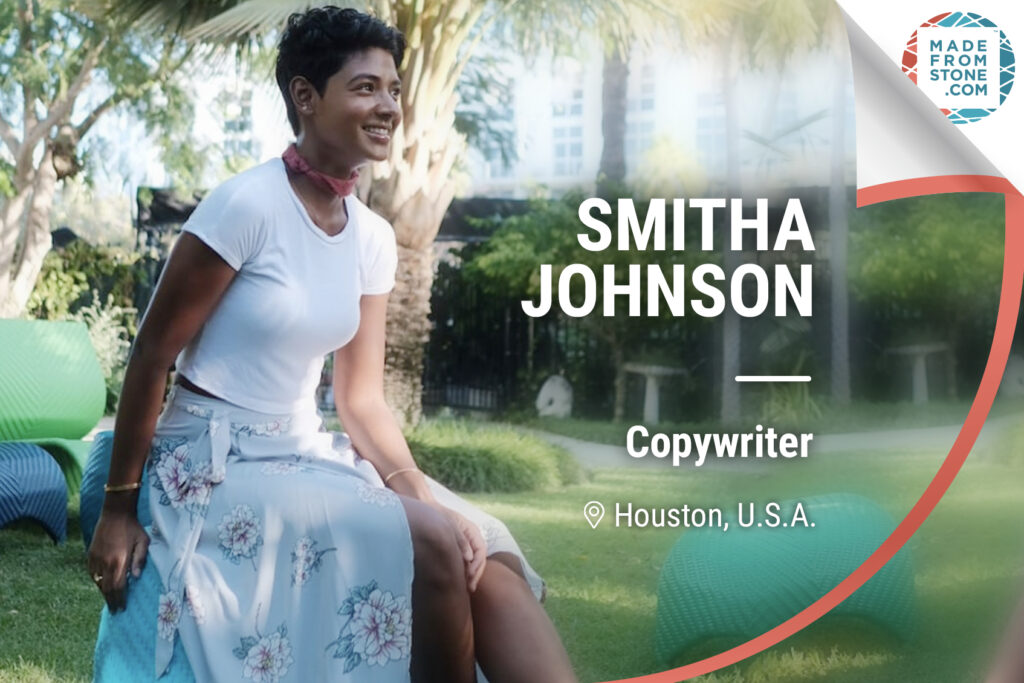
We are excited to highlight copywriter, Smitha Johnson, as our Rockstar of the month. She’s managed to blend her unique background in opera with her writing technique, resulting in her fluid melodic copy which you’ll see across various marketing material. After having lived all around the United States, Smitha finally settled in Miami. She is a passionate and extremely skilled member of our Okeanos team and we’re very lucky to have her.
Q: Smitha, tell us about your background.
A: I was born in Houston, Texas but my parents are from South India, from the state of Kerala. Growing up as a first generation Indian American and living in many different parts of the United States, I was constantly immersed in a variety of cultures. I did each level of schooling in a different area of the US. I attended Emory University in Atlanta, where I majored in English Literature and Music, specializing in Operatic Voice Performance. I headed to the Midwest after graduation to pursue a Masters in Music at Ohio State, and finished with a Performance Diploma at Indiana University. I was able to observe the unique characteristics of each region, from the nuances in language, to the dynamics between members of the population, and of course, the sheer variety of regional cuisines in America. My parents used to say that as a kid, I was always ready to run towards the next unknown adventure––I’ve continued to live my life that way, well into adulthood!
Q: From opera signing to copywriting, what inspired you to choose that path?
A: Although these two fields seem at odds with each other, they are united by one major thing: storytelling. An opera singer and a writer have similar tasks––to use their respective skills to convey the stories that connect us all. As an opera singer, I used my voice, my face, and my body to communicate stories that were usually written in languages audiences didn’t speak. Though many operas are quite old and seem out of touch with reality, at the core, these tales are timeless and universal in nature. My goal as a performer was to portray that. As a writer in advertising, I have a similar responsibility. I study culture, art, politics, and media, glean insights that anyone can relate to on a profoundly human level, and “translate” this into approachable language. The major difference is that now, I get to be in charge of the words, and have a much greater say in how these words come to life in campaigns.
Q: Words matter, now more than ever. Why do you think that is?
A: I think many people take language for granted these days. We are inundated with information and expected to communicate constantly. It’s more difficult to actually feel moved by what we read. As a copywriter, I see a huge opportunity here. I want to bring beautiful, nuanced language back in style. I believe that simple, compelling language, in a variety of forms, can help us understand and appreciate the fundamental truths that connect all people.
Q: How do you align yourself with the Okeanos mission?
A: Though I spent most of my life living far from the ocean, I always felt connected to the sea. But until now, I never knew how I could personally do anything to help protect it. Now that I live walking distance from the ocean, I can see how the choices we make as consumers directly impact the health of our oceans. I love that Okeanos takes inspiration from Nature to give back to Nature, and provides a message of empowerment for everyone. We are all capable of protecting our planet, even with the smallest choices we make!
Q: What are the most difficult and rewarding aspects of your role? Do you have any advice for someone looking to pursue copywriting?
A: As a copywriter, I often have to become an expert on highly detailed, complicated topics before I can begin writing about it. I then ask myself, “How can I write about these topics in a way that everyone can understand and enjoy?” This is often a tedious and arduous process, but it is a really gratifying feeling when I’m able to successfully communicate intricate ideas in a simple and engaging way. The best piece of advice for those interested in copywriting? Learn to love research, and be patient with yourself!
Q: Thus far, what has been the most exciting project you’ve worked on at Okeanos?
A: I am excited to bring our upcoming biomimicry campaign to life. I don’t think many people are aware of how important biomimicry is to technological innovation, and how central it is to Okeanos’ work. I look forward to the challenge of distilling the complexities of biomimicry into a campaign that is fun, humorous, and educational.
Q: What are some ways you try and lower your carbon footprint?
A: I am proud to say that I have successfully lived in Miami for two years without owning a car! I ride a bike to school and work, use it to run errands, and of course, for exercise. I’m a huge proponent for alternative transportation. I encourage others to explore the ways they can use the energy from their own bodies to get from Point A to Point B.
Q: Where do you see yourself and our planet in the next 5-10 years?
A: Given everything that is happening in the world, it is really difficult to say where I see myself in the next 5-10 years. But I’m keeping myself open to any and all opportunities. As long as my boyfriend, my cats, and my friends and family are happy, I can be happy pretty much anywhere. I’ve mostly lived in the South and on the East Coast, so living on the West Coast would be a fun change of scenery. In the near future, I hope that major brands and manufacturers will make a united, concerted effort to modify their production methods, opting for methods that have a much lower carbon footprint. I also hope that consumers will take a more active role in making eco-friendly product choices, rather than just choosing what is most convenient.
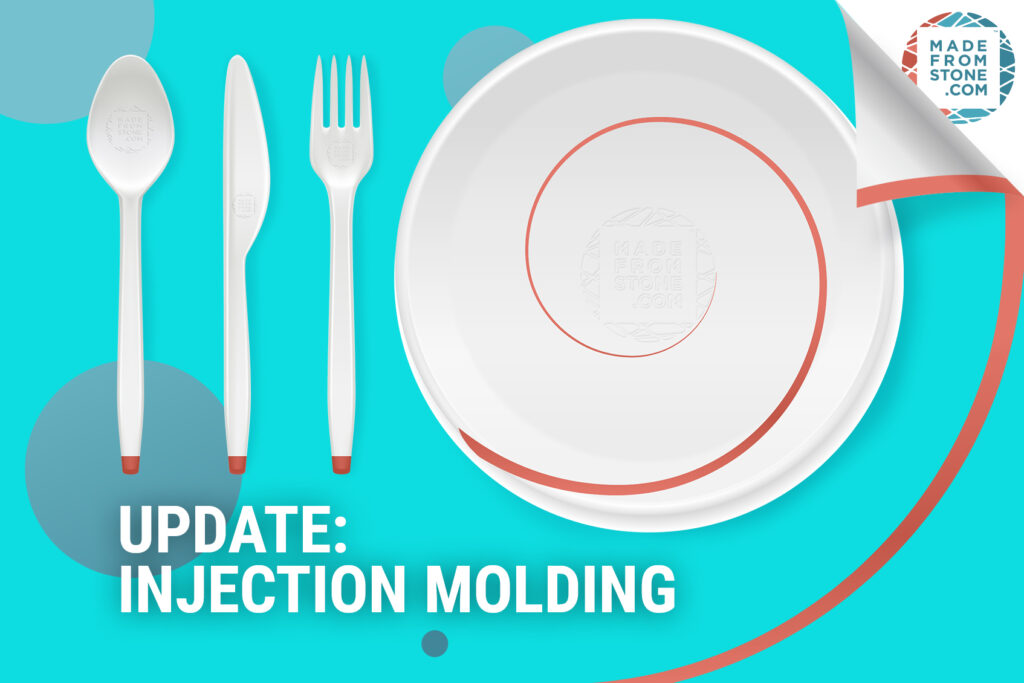
We are pleased to announce that we are now shipping our BC09 –Injection Molding Compound, out of the following countries: Brazil, Colombia, India, United States and Turkey. We will have additional capacity available within 60 days out of Spain, Mexico, Pakistan, and Vietnam. Please reach out to trade@madefromstone.com for information and samples of products including foodservice items, cosmetics, and food packaging.
| Cookie | Duration | Description |
|---|---|---|
| cookielawinfo-checkbox-analytics | 11 months | This cookie is set by GDPR Cookie Consent plugin. The cookie is used to store the user consent for the cookies in the category "Analytics". |
| cookielawinfo-checkbox-functional | 11 months | The cookie is set by GDPR cookie consent to record the user consent for the cookies in the category "Functional". |
| cookielawinfo-checkbox-necessary | 11 months | This cookie is set by GDPR Cookie Consent plugin. The cookies is used to store the user consent for the cookies in the category "Necessary". |
| cookielawinfo-checkbox-others | 11 months | This cookie is set by GDPR Cookie Consent plugin. The cookie is used to store the user consent for the cookies in the category "Other. |
| cookielawinfo-checkbox-performance | 11 months | This cookie is set by GDPR Cookie Consent plugin. The cookie is used to store the user consent for the cookies in the category "Performance". |
| viewed_cookie_policy | 11 months | The cookie is set by the GDPR Cookie Consent plugin and is used to store whether or not user has consented to the use of cookies. It does not store any personal data. |
